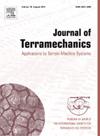高效灵活的轮胎-地形交互建模
IF 3.7
3区 工程技术
Q3 ENGINEERING, ENVIRONMENTAL
引用次数: 0
摘要
轮胎动力学分析是模拟车辆性能的基础。施加在轮胎上的力取决于轮胎与接触处地形的相互作用,而轮胎的结构直接影响这种相互作用。通常需要复杂的模型,如有限元或集总参数模型来准确地表示轮胎的灵活性。然而,这些模型的计算成本很高,不适合实时仿真。在这项工作中,我们开发了一个柔性轮胎-地形相互作用的简化模型。简化模型是一种较低保真度的表示,它以较低的计算成本捕获复杂系统的基本特征。该模型通过计算轮胎的有效刚度,并将其与刚体车轮模型相结合,有效地反映了轮胎柔性对车辆动力学的影响。我们观察到,接触片的大小直接影响牵引力,这取决于轮胎的变形。更大的接触片可以在滑动前产生更大的摩擦力。在该模型中,使用有效刚度来确定接触片的大小,然后相应地缩放摩擦系数。仿真结果表明,该模型实时性好,精度高,适合多种车辆仿真应用。本文章由计算机程序翻译,如有差异,请以英文原文为准。
Efficient flexible tire-terrain interaction modelling
The analysis of tire dynamics is essential in simulating vehicle behavior. The forces exerted on a tire depend on the interaction between the tire and the terrain at the contact patch, and the tire structure directly influences this interaction. Complex models, such as finite element or lumped-parameter models, are typically required to represent tire flexibility accurately. However, these models are computationally expensive, making them unsuitable for real-time simulation.
In this work, we develop a reduced model for flexible tire-terrain interaction. A reduced model is a lower-fidelity representation that captures essential features of a complex system at a significantly lower computational cost. Our model efficiently represents the influence of tire flexibility on vehicle dynamics by computing the effective stiffness of the tire and combining it with a rigid body wheel model.
We observe that the contact patch size, which depends on tire deformation, directly affects traction forces. A larger contact patch enables the generation of greater frictional force before slipping. In the proposed model, effective stiffness is used to determine the contact patch size, which then scales the friction coefficient accordingly.
Simulation results demonstrate efficient real-time performance with high accuracy, making the model well-suited for diverse vehicle simulation applications.
求助全文
通过发布文献求助,成功后即可免费获取论文全文。
去求助
来源期刊

Journal of Terramechanics
工程技术-工程:环境
CiteScore
5.90
自引率
8.30%
发文量
33
审稿时长
15.3 weeks
期刊介绍:
The Journal of Terramechanics is primarily devoted to scientific articles concerned with research, design, and equipment utilization in the field of terramechanics.
The Journal of Terramechanics is the leading international journal serving the multidisciplinary global off-road vehicle and soil working machinery industries, and related user community, governmental agencies and universities.
The Journal of Terramechanics provides a forum for those involved in research, development, design, innovation, testing, application and utilization of off-road vehicles and soil working machinery, and their sub-systems and components. The Journal presents a cross-section of technical papers, reviews, comments and discussions, and serves as a medium for recording recent progress in the field.
 求助内容:
求助内容: 应助结果提醒方式:
应助结果提醒方式:


